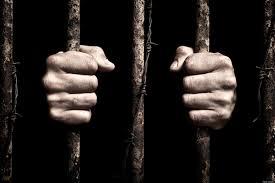
Cheryl Roberts is an ex-Judge, currently serving as Executive Director of the Greenburger Center for Social and Criminal Justice, as well as corporation counsel for the City of Hudson. She spoke recently to my humanist society. Her topic was mass incarceration — more specifically, the criminalization of mental illness and substance disorders.
America has the highest incarceration rate of any country. That’s right, of any country. We have less than 5% of the world’s population, but 25% of its prisoners. Our imprisonment rate is five to ten times higher than for other democracies.
Is it because we have that much more crime? Of course not. Though we do have way more gun crime because of our insane gun culture. Roberts noted that U.S. incarceration numbers rose from about 200,000 in 1973 to 2.2 million in 2009. Since then they’ve stayed at about that level. But during that interval crime rates actually fell dramatically. That decline was probably partially attributable to imprisoning dangerous people, though cultural/societal and demographic factors were likely more salient. In any case, an eleven-fold increase in incarceration obviously can’t be justified on the basis of crime rates.

It disproportionately affects mainly minority men under 40, who are already disadvantaged, educationally and economically, etc. For all Americans, the lifetime chance of being imprisoned is 6% [a scary enough figure]; for black men it’s 32%. And meantime, over half of the prisoner population suffers from some kind of mental illness. Such people are ten times likelier to see the inside of a prison than a psychiatric facility.
Also, for those with untreated mental illness, the risk of dying in interactions with police is 16 times greater than for people not so afflicted. And it’s not because the mentally ill are more likely to be engaged in criminality. Actually, according to Roberts, they are more likely to be victims of crime.

And prison, she said, is the last place they should be, suffering horribly there. It’s hard enough even for “normal” people to cope with imprisonment. Roberts cited a Virginia study of 400 prison deaths, finding 41% associated with solitary confinement, 44% were suicides, 18% were tasered, etc.
How did we get here? Roberts quoted John Ehrlichman (a Nixon confidante, speaking decades later) saying that the Nixon administration wanted to hit two “enemies” — blacks and anti-war leftist protesters. Launching a “war on drugs” with harsh penalties was a way to kill those two birds with one stone. It’s the war on drugs that still accounts for the bulk of America’s over-incarceration. Treating drugs, more sensibly, as a public health issue rather than a criminal justice one would go far toward addressing both the drug problem and the over-incarceration madness.

While drug use is correlated, to some degree, with mental problems, not all cases where mental problems get people in trouble with the law are drug-related. Mentally ill people used to be put in asylums; one such gave us the word “bedlam.” They were not indeed pleasant places. Thus there was a big societal push to get folks out of them. One impetus was adoption of a Medicaid rule prohibiting payment for most hospital care for the mentally ill.
Roberts noted that in the 1960s we had about 560,000 psychiatric hospital beds; four decades later it was down to about 50,000, for a national population double the size. Those beds came to be used mainly for people coming out of the criminal justice system, deemed incompetent to stand trial. While perhaps incongruously, what was originally the psychiatric hospital population was largely shifted into prisons. (Or into homelessness.)

Roberts said our high incarceration rate reflects a policy choice to use prison as a response to crime; and said it’s that policy that’s criminal. Actually, while certainly some very bad people are sent to prison, that’s not true of most inmates. And for them, incarceration is indeed a very bad, even self-defeating, societal response to whatever they’ve done. Partly that’s because prison is such a blunt tool; we call it the “correctional” system, but actually correcting antisocial behavior doesn’t much enter into it. With a little smartness, we could use prisons to help inmates overcome the personal problems that got them there. But such sensible programs* are very rare in U.S. prison systems.
* I’ve written about them: https://rationaloptimist.wordpress.com/2016/10/23/how-to-reduce-crime/
